
HOME
INTRO
SYMBOLS
ALMANAC
ECONOMY
GEOGRAPHY
STATE MAPS
PEOPLE
FORUM
NEWS
COOL SCHOOLS
STATE QUIZ
STATE LINKS
BOOK STORE
MARKETPLACE
NETSTATE.STORE
NETSTATE.MALL
GUESTBOOK
CONTACT US


Tweet
Double click any word in document for definition.
Texas State Bison Herd
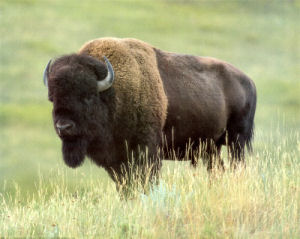
Texas State Bison Herd: Herd at Caprock Canyons State Park
Photographs, prints, and posters
Texas State Bison Herd at Caprock Canyons State Park became the official state bison herd of Texas when Governor Scott Perry signed House Concurrent Resolution No. 86 on June 17, 2011.
H.C.R. No. 86
HOUSE CONCURRENT RESOLUTION
WHEREAS, The State of Texas has customarily recognized a variety of official symbols as tangible representations of the state's historical and cultural heritage; figuring prominently in that distinctive list are animals that played a central role in the rich Western heritage of Texas, including the longhorn and the American quarter horse; and
WHEREAS, Another deserving candidate for recognition is the bison, popularly known as the buffalo; after arriving in North America some 25,000 years ago, the bison adapted particularly well to the environment of the Great Plains; by the 1700s, as many as 60 million buffalo were living on the continent, and the lands that were to become Texas were among the areas roamed by the vast herds; and
WHEREAS, The animals were central to the livelihood of the Native Americans of the Great Plains, providing not only their main diet but also materials for shelter, clothing, and many other staples; the ample supply of bison and the hunting culture of the Plains tribes were not to last, however; with the completion of the transcontinental railroad in 1869, it became possible to profitably ship bison hides and meat to eastern markets by rail, and in the next 15 years, buffalo hunters almost completely exterminated the herds; by 1885, fewer than 1,000 animals remained; and
WHEREAS, Fortunately, some Texans had the foresight to try and save this noble creature; Mary Ann "Molly" Goodnight, the wife of legendary Texas rancher Charles Goodnight, was so distressed by the rapid disappearance of the bison that she convinced her husband to begin capturing and protecting bison calves from the small number of wild animals that remained on the Southern Plains; he began to round up young bison in the 1870s in the northern Texas Panhandle, and the herd at Goodnight's JA Ranch eventually grew to about 250 head by the time Mr. Goodnight passed away in 1929; and
WHEREAS, The Goodnight bison herd became one of the five foundation herds in the United States from which the majority of surviving buffalo have developed; a number of animals directly descended from the Goodnight stock were donated to the Texas Parks and Wildlife Department in 1996, and a subset of that group was determined to be a pure strain that had not been crossbred with bison from other areas; given a home at Caprock Canyons State Park, those buffalo and their offspring are today known as the Texas State Bison Herd and are notable for their strong genetic link to the original Southern Plains buffalo and because they continue to live in the area where their ancestors were first caught; and
WHEREAS, In both its historical significance and its enduring connections to Texas imagery and culture, the Texas State Bison Herd at Caprock Canyons State Park is indeed a fitting symbol for the Lone Star State; now, therefore, be it
RESOLVED, That the 82nd Legislature of the State of Texas hereby designate the Texas State Bison Herd at Caprock Canyons State Park as the official State Bison Herd of Texas.
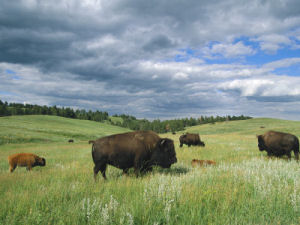
Texas State Bison Herd: Herd at Caprock Canyons State Park
Photographs, prints, and posters
Texas Law
The official state bison herd was adopted by House Concurrent Resolution No. 86 and is, therefore, not listed in the Texas Statutes.
Only a small number of Texas' myriad symbols have been actually adopted by an act of the legislature and written into the Texas Statutes.
Sources...
"House Concurrent Resolution No. 86." The Texas Legislature Online. The State of Texas, 2011. Web. 29 Sep 2011. .
Texas Parks & Wildlife Video from Caprock Canyons State Park
Additional Information
Caprock Canyons State Park & Trailway: Texas Parks and Wildlife Department.
American Bison Society: Official website of the American Bison Society founded in 1905.
At Home on the Range Again: Article by Russell Roe, Texas Parks and Wildlife Magazine (March 2011).
American Buffalo: Spirit of a Nation: PBS Nature series.
Bison bison (American bison): Smithsonian Museum of Natural History - North American Mammals.
Bison bison (American bison): The University of Michigan Museum of Zoology: Animal Diversity Web.
Bos bison - (Linnaeus, 1758), American bison: A network connecting science with conservation - NatureServe Explorer: An Online Encyclopedia of Life.
Bison bison (Linnaeus, 1758): Integrated Taxonomic Information System (ITIS) Here you will find authoritative taxonomic information on plants, animals, fungi, and microbes of North America and the world.
State Mammals: Complete list of official state mammals from NETSTATE.COM.
More symbols & emblems: Complete list of official Texas state symbols from NETSTATE.COM.
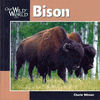
Bison
Cherie Winner
Bison (Our Wide World), by Cherie Winner. 48 pages. Publisher: Northword Books (March 1, 2001) Reading level: Ages 9-12. Bison provides information about where the Bison live, what they eat, when they sleep, how they raise their young, and much more. Lots of vivid, full color photographs and illustrations. Sidebar 'Fun Facts,' an index, and a list of useful Internet Sites. There is plenty to interest report writers and animal lovers in this book.
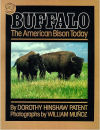
Buffalo
Dorothy Patent
Buffalo: The American Bison Today, by Dorothy Hinshaw Patent. 80 pages. Publisher: Sandpiper (October 18, 1993) Reading level: Ages 9-12. A vivid description of the life of the buffalo in each season of the year details its ways of courtship, birth, and winter survival. "Will make a useful addition to any library collection not only as a behavioral study of the American bison but as a success story in wildlife management and the return of an endangered species." -- School Library Journal, starred review School Library Journal Best Books of the Year.
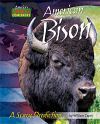
American Bison
William Caper
American Bison: A Scary Prediction, by William Caper. 32 pages. Publisher: Bearport Publishing (July 31, 2007) Reading level: ages 9-12. Was it too late to save the American bison? For thousands of years, this remarkable creature had lived peacefully in North America. Yet by 1889, years of hunting had pushed the animal to the brink of extinction. Would people find a way to help the bison survive?
In American Bison: A Scary Prediction, children relive the inspiring and heroic efforts of people who stepped in to save this remarkable creature when all seemed lost. Through this true tale of wildlife survival, readers discover the bold and creative ideas that Americans and their government have used to protect and care for the country’s endangered wildlife.
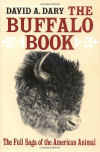
The Buffalo Book
David A. Dary
The Buffalo Book: The Full Saga of the American Animal , by David A. Dary. 384 pages. Swallow Press; 1 edition (December 1, 1989) The journals and memoirs of 19th century explorers and travelers in the American West often told of viewing buffalo massed together as far as the eye could see. This book appropriately covers the subject of the buffalo as extensively as that animal covered the plains. Other recent accounts of the buffalo have focused on two or three aspects, emphasizing its natural history, the hunters and the hunted in prehistoric time, the relationship between the buffalo and the American Indian. David Dary's treatment stretches from horizon to horizon. Of course he discusses the origin of the buffalo in North America, its locations and migrations, its habits, its significance and role in both Indian and white cultures, its near demise, its salvation. But more. Dary weaves throughout his fact-filled book fascinating threads of lore and legend of this animal that literally helped mold who and what America is. Further, in addition to detailing the extinction which almost befell this mythic beast and the attempts to give life again to the herds, Dary concentrates significant attention on the buffalo as part of 20th century America in terms of captivity, husbandry, and symbol.
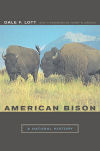
American Bison
Dale F. Lott
American Bison: A Natural History, by Dale F. Lott. 245 pages. Publisher: University of California Press; 1 edition (November 1, 2003) American Bison combines the latest scientific information and one man's personal experience in an homage to one of the most magnificent animals to have roamed America's vast, vanished grasslands. Dale F. Lott, a distinguished behavioral ecologist who was born on the National Bison Range and has studied the buffalo for many years, relates what is known about this iconic animal's life in the wild and its troubled history with humans. Written with unusual grace and verve, American Bison takes us on a journey into the bison's past and shares a compelling vision for its future, offering along the way a valuable introduction to North American prairie ecology.

